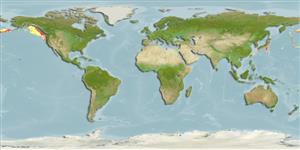Heteronymphon bioculatum Turpaeva, 1956
| Native range | All suitable habitat | Point map | Year 2050 |

|
| This map was computer-generated and has not yet been reviewed. |
| Heteronymphon bioculatum AquaMaps Data sources: GBIF OBIS |
Upload your photos
Google image |
No photo available for this species.No drawings available for Nymphonidae.
Google image |
No photo available for this species.
Classification / Names Common names | Synonyms | CoL | ITIS | WoRMS
Pycnogonida | Pantopoda | Nymphonidae
Environment: milieu / climate zone / depth range / distribution range Ecology
Benthic; depth range 756 - 3940 m (Ref. 2157). Temperate
Distribution Countries | FAO areas | Ecosystems | Occurrences | Introductions
Northern Pacific: USA.
Length at first maturity / Size / Weight / Age
Maturity: Lm ? range ? - ? cm
Short description Morphology
Ocular tubercle well developed with large anterior pair of eyes, posterior pair either inconspicuous or lacking. With two of above males , anterior pair of eyes quite conspicuous but slightly pigmented, smaller posterior pair of eyes present but very inconspicuous, apparently unpigmented. Lateral processes well separated in quite slender species. Terminal palp segment shorter than penultimate segment. Oviger claw short, without teeth, no longer than distal denticulate spines of terminal segment. Spines with either two or three lateral lobes. Propodus shorter than slender tarsus with terminal claw little more than half length of propodus. Male cement gland apertures several inconspicuous ventral pores on femorae (Ref. 2157, p. 7).
Bathyal to abyssal (Ref. 19).
Life cycle and mating behavior Maturity | Reproduction | Spawning | Eggs | Fecundity | Larvae
Members of the class Pycnogonida are gonochoric and sexually dimorphic. During copulation, male usually suspends itself beneath the female. Fertilization occurs as the eggs leave the female's ovigers. Males brood the egg masses until they hatch. Life cycle: Eggs hatch into protonymphon larva then to adults.
Main reference
References | Coordinator | Collaborators
Child, C.A. 1994. (Ref. 2157)
IUCN Red List Status (Ref. 130435)
CITES status (Ref. 108899)
Not Evaluated
CMS (Ref. 116361)
Not Evaluated
Threat to humans
Human uses
| FishSource |
Tools
More information
Internet sources
BHL | BOLD Systems | CISTI | DiscoverLife | FAO(Publication : search) | Fishipedia | GenBank (genome, nucleotide) | GloBI | Gomexsi | Google Books | Google Scholar | Google | PubMed | Tree of Life | Wikipedia (Go, Search) | Zoological Record
Estimates based on models
Price category
(Ref. 80766):
Unknown.


